Polar Order Evolutions near the Rhombohedral to Pseudocubic and Tetragonal to Pseudocubic Phase Boundaries of the BiFeO3-BaTiO3 System
Abstract
:1. Introduction
2. Experimental Methods
| Compositions | Temperature (°C) | |
|---|---|---|
| Calcination | Sintering | |
| 0.95BF-0.05BT | 750 | 930 |
| 0.9BF-0.1BT | 750 | 960 |
| 0.8BF-0.2BT | 750 | 980 |
| 0.75BF-0.25BT | 800 | 990 |
| 0.7BF-0.3BT | 800 | 1000 |
| 0.65BF-0.35BT | 800 | 1050 |
| 0.6BF-0.4BT | 800 | 1050 |
| 0.55BF-0.45BT | 850 | 1090 |
| 0.5BF-0.5BT | 900 | 1100 |
| 0.4BF-0.6BT | 950 | 1140 |
| 0.2BF-0.8BT | 1000 | 1220 |
| 0.1BF-0.9BT | 1080 | 1260 |
| 0.04BF-0.96BT | 1140 | 1340 |
| 0.02BF-0.98BT | 1140 | 1340 |
3. Results and Discussion
3.1. Structural and Electrical Properties near the R-PC Phase Boundary
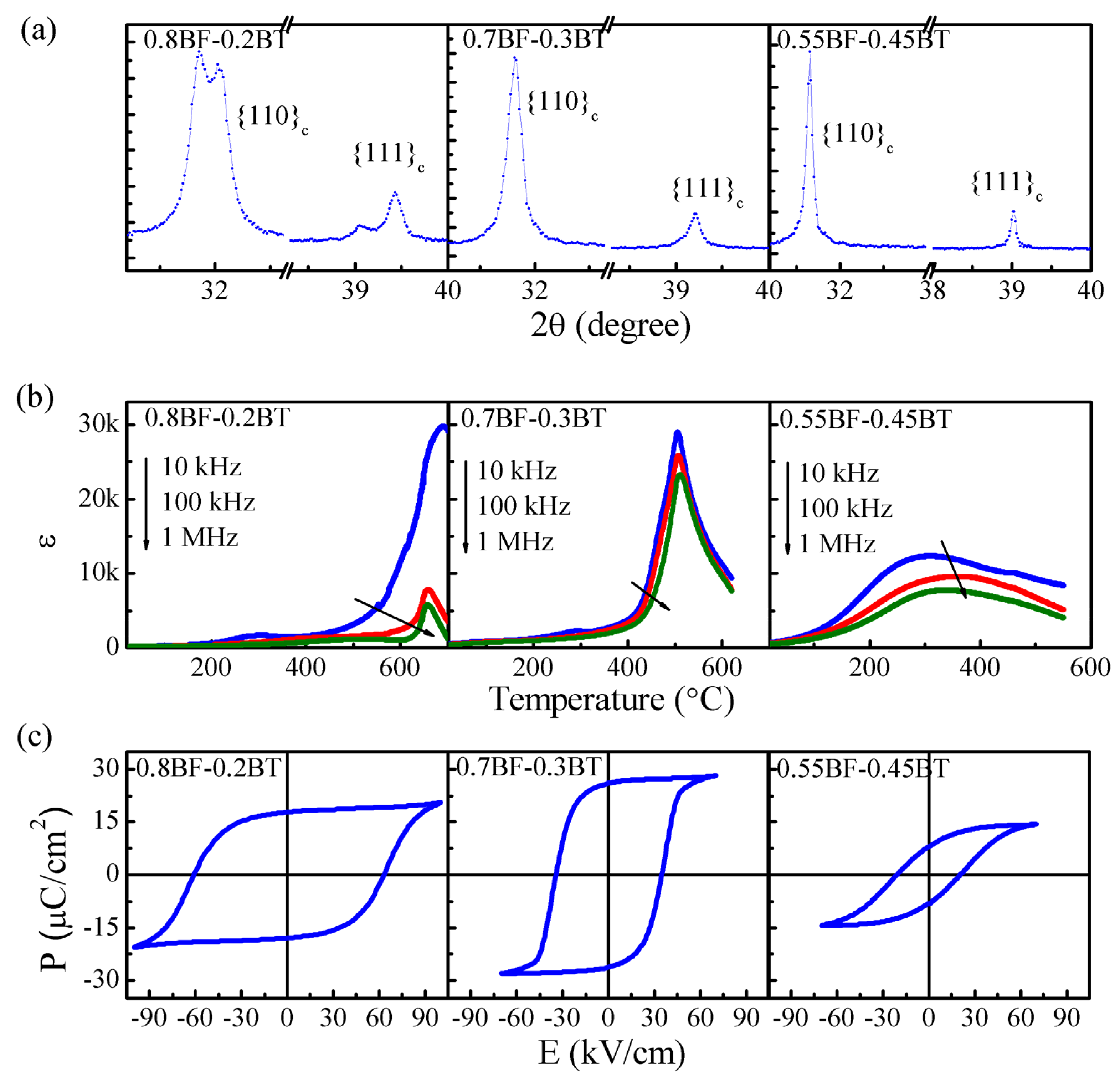
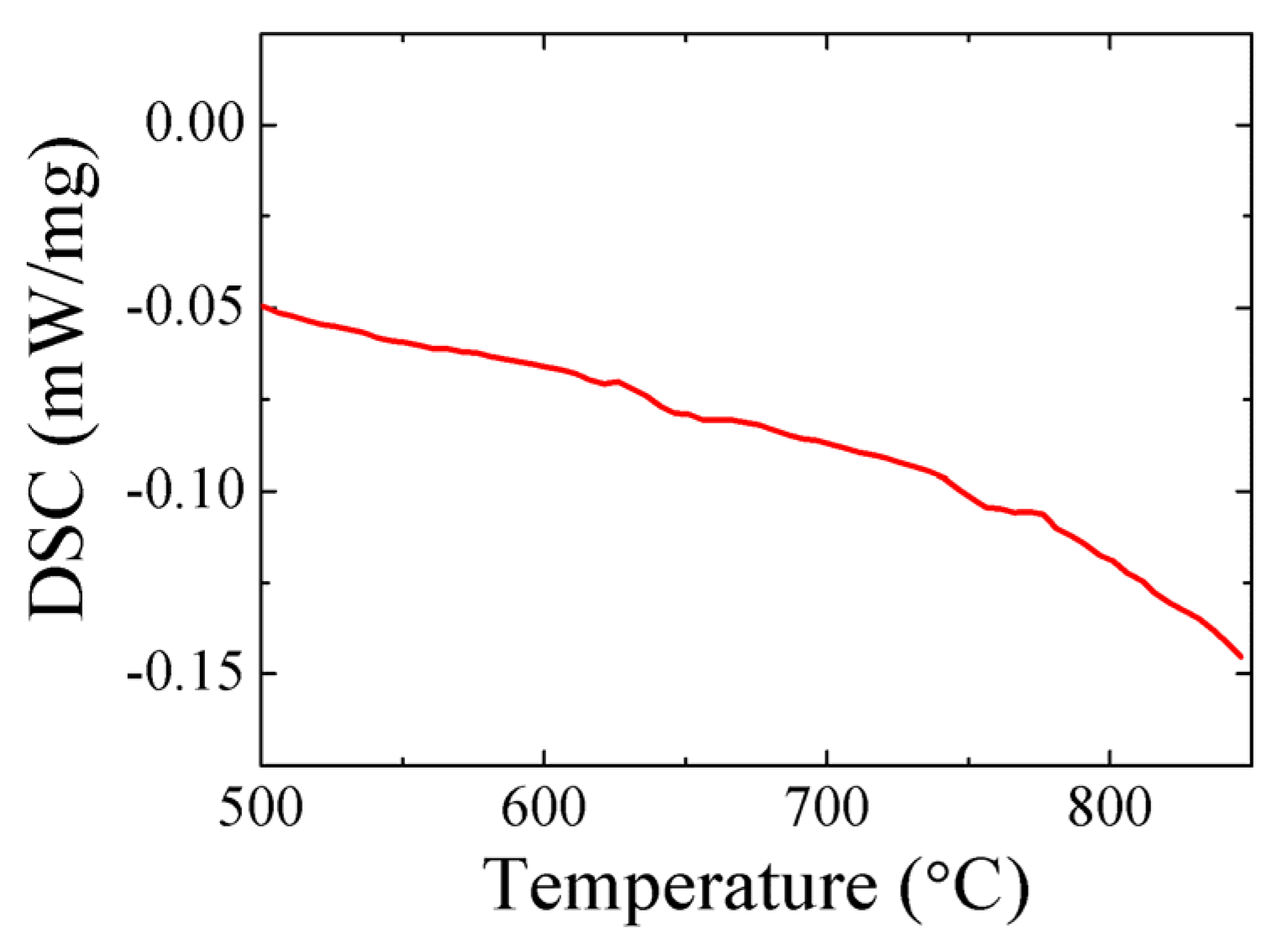
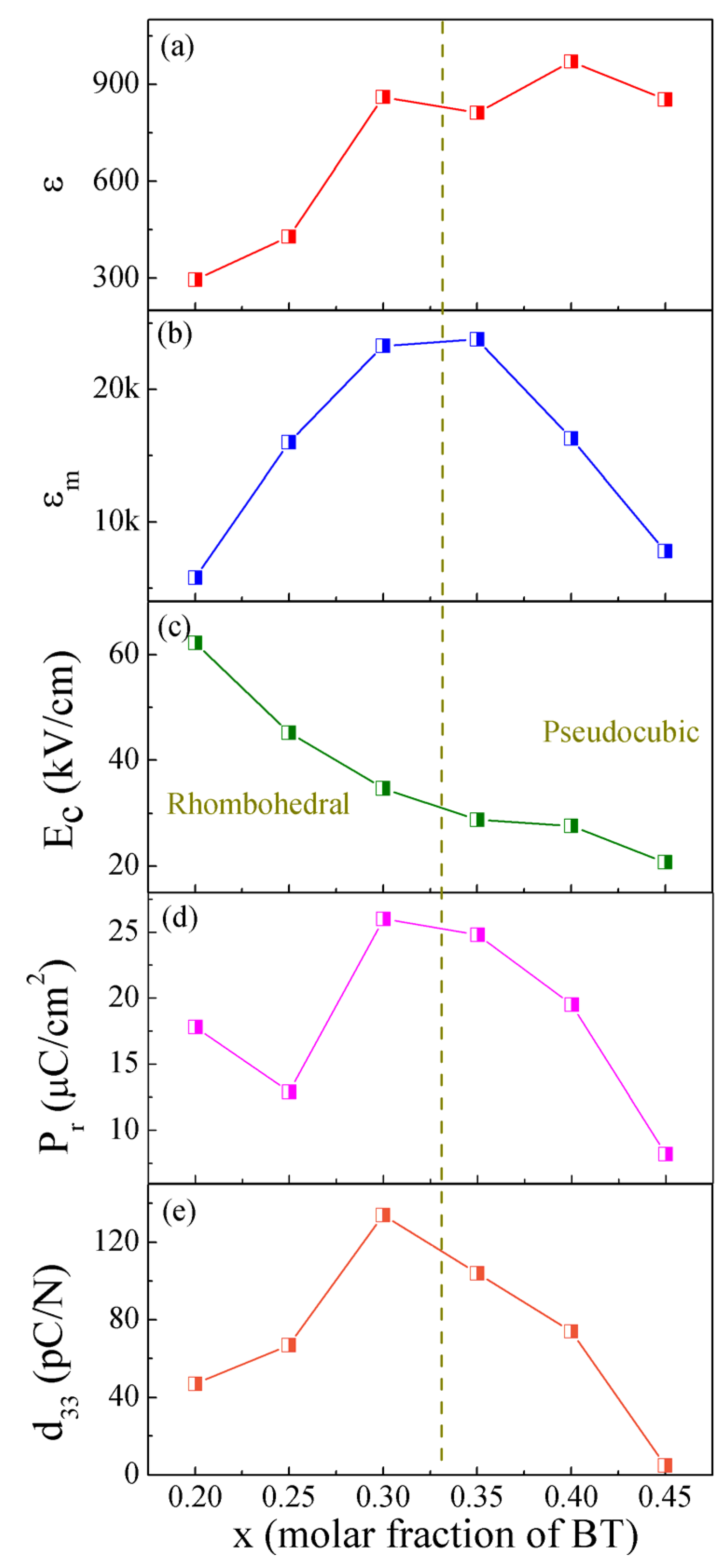
| Compositions | Pr (μC/cm2) | Ec (kV/cm) | d33 (pC/N) | Tc/Tm (°C) | References |
|---|---|---|---|---|---|
| 0.7BF-0.3BT | 26.0 | 34.6 | 134 | 511 | - |
| BF | ~13 | >50 | 44 | 830~850 | [1,24] |
| Bi0.92Dy0.08FeO3 | 25.2 | >100 | 37 | - | [25] |
| Bi0.875Sm0.125FeO3 | 15.1 | >80 | 29 | - | [26] |
| Bi0.91La0.05Tb0.04FeO3 | - | - | 9 | - | [27] |
| Bi0.85La0.15FeO3 | 12.1 | >60 | 28 | - | [28] |
| (Bi1-xNdx)FeO3(x = 0–0.15) | - | - | 26~28 | - | [29] |
| 0.675BiFeO3-0.325PbTiO3 | 62 | >40 | 85 | 642 | [30] |
| 0.6BiFeO3-0.4(Bi0.5K0.5)TiO3 | ~15 | ~40 | 37 | 441 | [31] |
| 0.57(Bi0.8La0.2)(Ga0.05Fe0.95)O3-0.43PbTiO3 | ~30 | ~20 | 295 | 264 | [32] |
| 0.511BiFeO3-0.326PbZrO3-0.163PbTiO3 | ~12 | ~40 | 101 | 431 | [33] |
| 0.33BiFeO3-0.2BaZrO3-0.47PbTiO3 | ~30 | ~20 | ~270 | 270 | [34] |
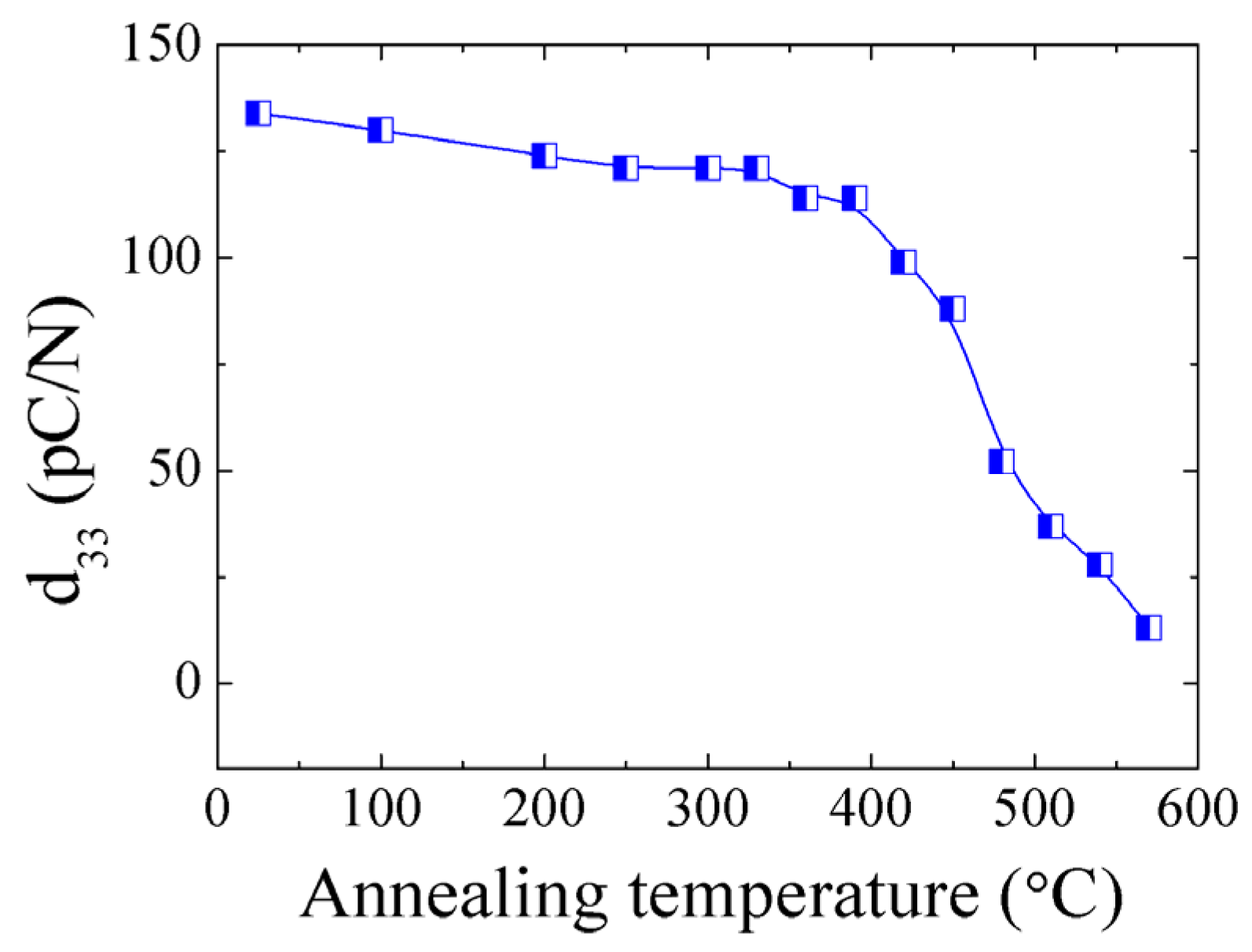

3.2. Structural and Electrical Properties near the T-PC Phase Boundary
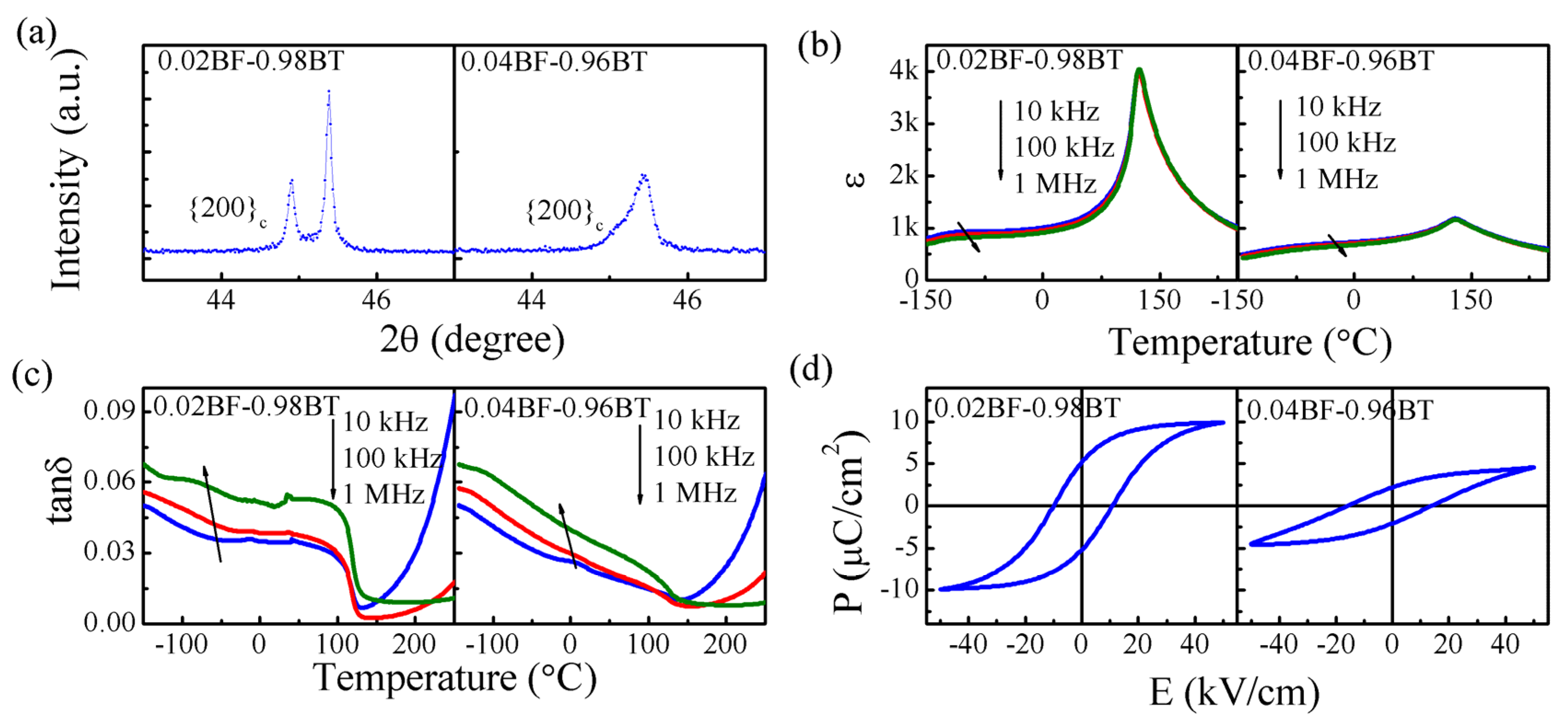
3.3. Composition Dependence of Lattice Parameters
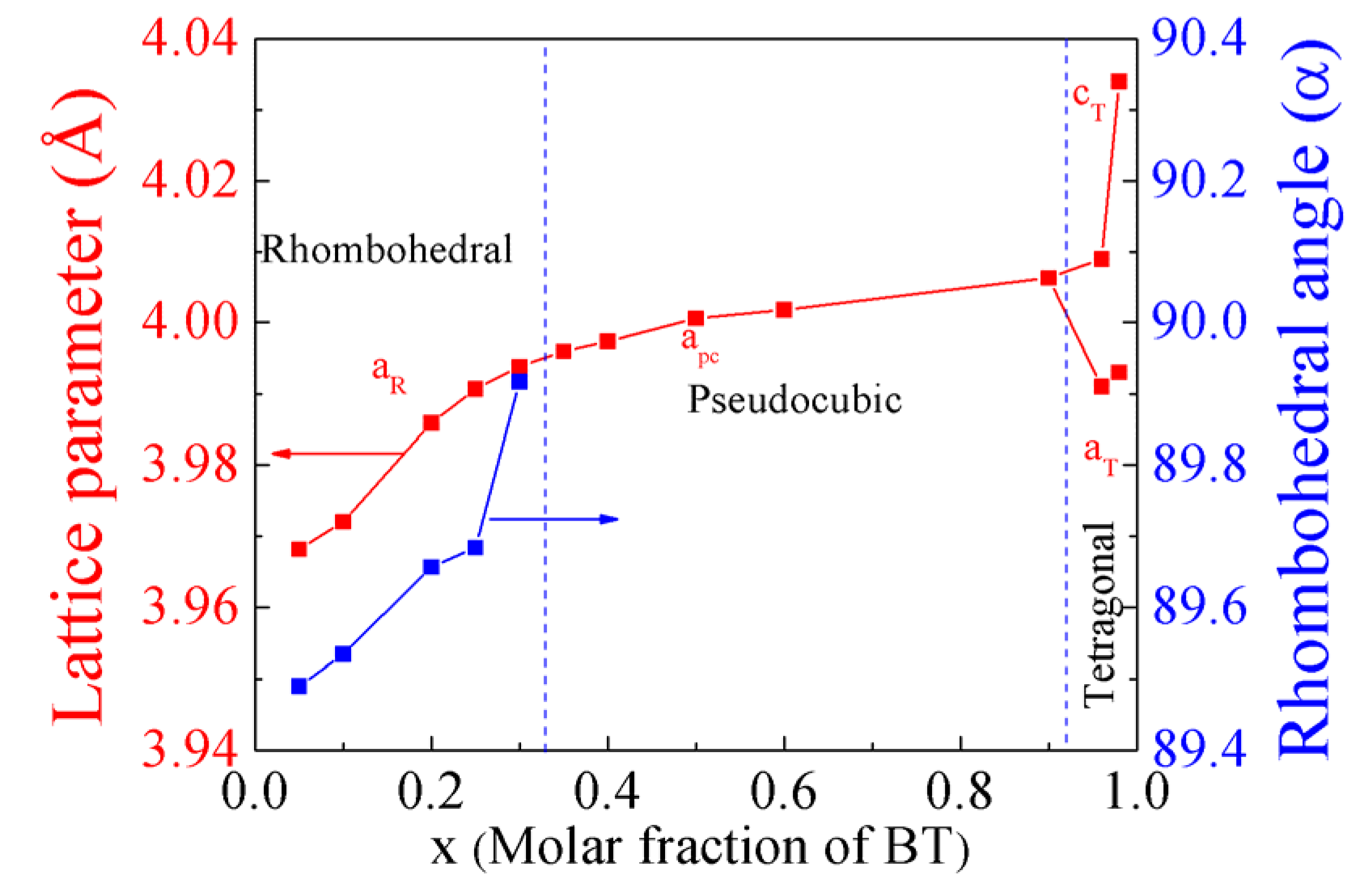
3.4. Possible Reasons for the Different Behaviors near the Two Phase Boundaries
4. Conclusions
Supplementary Materials
Acknowledgments
Author Contributions
Conflicts of Interest
References
- Catalan, G.; Scott, J.F. Physics and applications of bismuth ferrite. Adv. Mater. 2009, 21, 2463–2485. [Google Scholar] [CrossRef]
- Belik, A.A.; Likubo, S.; Kodama, K.; Igawa, N.; Shamoto, S.; Maie, M.; Nagai, T.; Matsui, Y.; Stefanovich, S.Y.; Lazoryak, B.I.; et al. BiScO3: Centrosymmetric BiMnO3-type oxide. J. Am. Chem. Soc. 2006, 128, 706–707. [Google Scholar] [CrossRef] [PubMed]
- Suchomel, M.R.; Fogg, A.M.; Allix, M.; Niu, H.J.; Claridge, J.B.; Rosseinsky, M.J. Bi2ZnTiO6: A lead-free closed-shell polar perovskite with a calculated ionic polarization of 150 μC/cm2. Chem. Mater. 2006, 18, 4987–4989. [Google Scholar] [CrossRef]
- Khalyavin, D.D.; Salak, A.N.; Vyshatko, N.P.; Lopes, A.B.; Olekhnovich, N.M.; Pushkarev, A.V.; Maroz, I.I.; Radyush, Y.V. Crystal structure of metastable perovskite Bi(Mg1/2Ti1/2)O3:Bi-based structural analogue of antiferroelectric PbZrO3. Chem. Mater. 2006, 18, 5104–5110. [Google Scholar] [CrossRef]
- Eitel, R.E.; Randall, C.A.; Shrout, T.R.; Park, S.E. Preparation and characterization of high temperature perovskite ferroelectrics in the solid-solution (1-x)BiScO3-xPbTiO3. Jpn. J. Appl. Phys. 2002, 41, 2099–2104. [Google Scholar] [CrossRef]
- Alguero, M.; Ramos, P.; Jimenez, R.; Amorin, H.; Vila, E.; Castro, A. High temperature piezoelectric BiScO3-PbTiO3 synthesized by mechanochemical methods. Acta Mater. 2012, 60, 1174–1183. [Google Scholar] [CrossRef]
- Randall, C.A.; Eitel, R.E.; Jones, B.; Shrout, T.R.; Woodward, D.I.; Reaney, I.M. Investigation of a high Tc piezoelectric system: (1-x)Bi(Mg1/2Ti1/2)O3-xPbTiO3. J. Appl. Phys. 2004, 95, 3633–3639. [Google Scholar] [CrossRef]
- Liu, J.F.; Chen, X.X.; Xu, G.S.; Yang, D.F.; Tian, Y.F.; Zhu, X. Novel high temperature ferroelectric single crystals 0.38Bi(Mg1/2Ti1/2)O3-0.62PbTiO3 with good and temperature-stable piezoelectric properties. CystEngComm 2015, 10, 5605–5608. [Google Scholar] [CrossRef]
- Ogihara, H.; Randall, C.A.; Trolier-McKinstry, S. Weakly coupled relaxor behavior of BaTiO3-BiScO3 ceramics. J. Am. Ceram. Soc. 2009, 92, 110–118. [Google Scholar] [CrossRef]
- Yu, H.C.; Ye, Z.G. Dielectric properties and relaxor behavior of a new (1-x)BaTiO3-xBiAlO3 solid solution. J. Appl. Phys. 2008, 103. [Google Scholar] [CrossRef]
- Huang, C.C.; Cann, D.P. Phase transitions and dielectric properties in Bi(Zn1/2Ti1/2)O3-BaTiO3 perovskite solid solutions. J. Appl. Phys. 2008, 104. [Google Scholar] [CrossRef]
- Kumar, M.M.; Srinivas, A.; Suryanarayana, S.V. Structure property relations in BiFeO3/BaTiO3 solid solutions. J. Appl. Phys. 2000, 87, 855–862. [Google Scholar] [CrossRef]
- Singh, A.; Pandey, V.; Kotnala, R.K.; Pandey, D. Direct evidence for multiferroic magnetoelectric coupling in 0.9BiFeO3-0.1BaTiO3. Phys. Rev. Lett. 2008, 101. [Google Scholar] [CrossRef] [PubMed]
- Gheorghiu, F.P.; Ianculescu, A.; Postolache, P.; Lupu, N.; Dobromir, M.; Luca, D.; Mitoseriu, L. Preparation and properties of (1-x)BiFeO3-xBaTiO3 multiferroic ceramics. J. Alloys Compd. 2010, 506, 862–867. [Google Scholar] [CrossRef]
- Ozaki, T.; Kitagawa, S.; Nishihara, S.; Hosokoshi, Y.; Suzuki, M.; Noguchi, Y.; Miyayama, M.; Mori, S. Ferroelectric properties and nano-scaled domain structures in (1-x)BiFeO3–xBaTiO3 (0.33 < x < 0.50). Ferroelectrics 2009, 385, 6155–6161. [Google Scholar]
- Wei, Y.X.; Wang, X.T.; Jia, J.J.; Wang, X.L. Multiferroic and piezoelectric properties of 0.65BiFeO3-0.35BaTiO3 ceramic with pseudo-cubic symmetry. Ceram. Int. 2012, 38, 3499–3502. [Google Scholar] [CrossRef]
- Futakuchi, T.; KaKuda, T.; Sakai, Y. Multiferroic properties of BiFeO3-BaTiO3 based ceramics. J. Ceram. Soc. Jpn. 2014, 122, 464–468. [Google Scholar] [CrossRef]
- Leontsev, S.O.; Eitel, R.E. Dielectric and piezoelectric properties in Mn-modified (1-x)BiFeO3-xBaTiO3 ceramics. J. Am. Ceram. Soc. 2009, 92, 2957–2961. [Google Scholar] [CrossRef]
- Yang, H.B.; Zhou, C.R.; Liu, X.Y.; Zhou, Q.; Chen, G.H.; Wang, H.; Li, W.Z. Structural, microstructural and electrical properties of BiFeO3-BaTiO3 ceramics with high thermal stability. Mater. Res. Bull. 2012, 47, 4233–4239. [Google Scholar] [CrossRef]
- Wei, Y.X.; Wang, X.T.; Zhu, J.T.; Wang, X.L.; Jia, J.J. Dielectric, ferroelectric and piezoelectric properties of BiFeO3-BaTiO3 ceramics. J. Am. Ceram. Soc. 2013, 96, 3163–3168. [Google Scholar]
- Singh, A.; Moriyoshi, C.; Kuroiwa, Y.; Pandey, D. Evidence for diffuse ferroelectric phase transition and cooperative tricritical freezing of random-site dipoles due to off-centered Bi3+ ions in the average cubic lattice of (Ba1-xBix)(Fe1-xTix)O3. Phys. Rev. B 2012, 85. [Google Scholar] [CrossRef]
- Kumar, M.M.; Suresh, M.B.; Suryanarayana, S.V.; Kumar, G.S.; Bhimasankaram, T. Dielectric relaxation in Ba0.96Bi0.04Ti0.96Fe0.04O3. J. Appl. Phys. 1998, 84, 6811–6814. [Google Scholar] [CrossRef]
- Wang, L.; Wang, X.L.; Shi, J. Measurement and estimation of ferroelectric hysteresis loops. Ferroelectrics 2010, 411, 86–92. [Google Scholar] [CrossRef]
- Rojac, T.; Kosec, M.; Budic, B.; Setter, N.; Damjanovic, D. Strong ferroelectric domain-wall pinning in BiFeO3 ceramics. J. Appl. Phys. 2010, 108, 074107. [Google Scholar] [CrossRef]
- Sun, C.; Chen, X.M.; Wang, J.L.; Yuan, G.L.; Yin, J.; Liu, Z.G. Structure and piezoelectric properties of BiFeO3 and Bi0.92Dy0.08FeO3 multiferroics at high temperature. Solid State Commun. 2012, 152, 1194–1198. [Google Scholar] [CrossRef]
- Yuan, G.L.; Or, S.W. Multiferroicity in polarized single-phase Bi0.875Sm0.125FeO3 ceramics. J. Appl. Phys. 2006, 100. [Google Scholar] [CrossRef]
- Jiang, Q.H.; Liu, F.T.; Nan, C.W.; Lin, Y.H.; Reece, M.J.; Yan, H.X.; Ning, H.P.; Shen, Z.J. High-temperature ferroelectric phase transition observed in multiferroic Bi0.91La0.05Tb0.04FeO3. Appl. Phys. Lett. 2009, 95. [Google Scholar] [CrossRef]
- Yuan, G.L.; Baba-Kishi, K.Z.; Liu, J.M.; Or, S.W.; Wang, Y.P.; Liu, Z.G. Multiferroic properties of single-phase Bi0.85La0.15FeO3 lead-free ceramics. J. Am. Ceram. Soc. 2006, 89, 3136–3139. [Google Scholar] [CrossRef]
- Yuan, G.L.; Or, S.W. Enhanced piezoelectric and pyroelectric effects in single-phase multiferroic Bi1−xNdxFeO3 (x = 0–0.15) ceramics. Appl. Phys. Lett. 2006, 88, 1–3. [Google Scholar] [CrossRef]
- Amorín, H.; Correas, C.; Ramos, P.; Hungría, T.; Castro, A.; Algueró, M. Very high remnant polarization and phase-change electromechanical response of BiFeO3-PbTiO3 at the multiferroic morphotropic phase boundary. Appl. Phys. Lett. 2012, 101. [Google Scholar] [CrossRef]
- Bennett, J.; Bell, A.J.; Stevenson, T.J.; Smith, R.I.; Sterianou, I.; Reaney, I.M.; Comyn, T.P. Multiferroic properties of BiFeO3-(K0.5Bi0.5)TiO3 ceramics. Mater. Lett. 2013, 94, 172–175. [Google Scholar] [CrossRef]
- Cheng, J.R.; Eitel, R.E.; Cross, L.E. Lanthanum-modified (1-x)(Bi0.8La0.2)(Ga0.05Fe0.95)O3-xPbTiO3 crystalline solutions: Novel morphotropic phase-boundary lead-reduced piezoelectrics. J. Am. Ceram. Soc. 2003, 86, 2111–2115. [Google Scholar] [CrossRef]
- Hu, W.; Tan, X.L.; Rajan, K. Piezoelectric ceramics with compositions at the morphotropic phase boundary in the BiFeO3-PbZrO3-PbTiO3 ternary system. J. Am. Ceram. Soc. 2011, 94, 4358–4363. [Google Scholar] [CrossRef]
- Fan, L.L.; Chen, J.; Li, S.; Kang, H.J.; Liu, L.J.; Fang, L.; Xing, X.R. Enhanced piezoelectric and ferroelectric properties in the BaZrO3 substituted BiFeO3-PbTiO3. Appl. Phys. Lett. 2013, 102. [Google Scholar] [CrossRef]
- Singh, A.; Senyshyn, A.; Fuess, H.; Pandey, D. Ferroelectric and antiferrodistortive phase transition in the multiferroic (Bi0.8Ba0.2)(Fe0.8Ti0.2)O3: A high temperature neutron powder diffraction study. J. Appl. Phys. 2011, 110. [Google Scholar] [CrossRef]
- Shrout, T.R.; Zhang, S.J. Lead-free piezoelectric ceramics: Alternatives for PZT? J. Electroceram. 2007, 19, 111–124. [Google Scholar] [CrossRef]
- Craciun, F.; Galassi, C.; Birjega, R. Electric-field-induced and spontaneous relaxor-ferroelectric phase transitions in (Na1/2Bi1/2)1-xBaTiO3. J. Appl. Phys. 2012, 112, 124106. [Google Scholar] [CrossRef]
- Lalitha, K.V.; Kalyani, A.K.; Ranjan, R. Analogous stress and electric field driven structural transformation and decrease in polarization coherence on poling around the morphotropic phase boundary in BiScO3-PbTiO3. Phys. Rev. B 2014, 90, 224107. [Google Scholar] [CrossRef]
- Damjanovic, D. A morphotrophic phase boundary system based on polarization rotation and polarization extension. Appl. Phys. Lett. 2010, 97, 062906. [Google Scholar] [CrossRef]
- Wu, J.G.; Xiao, D.Q.; Zhu, J.G. Potassium-sodium niobate lead-free piezoelectric materials: Past, present, and future of phase boundaries. Chem. Rev. 2015, 115, 2559–2595. [Google Scholar] [CrossRef] [PubMed]
- Noblanc, O.; Gaucher, P.; Calvarin, G. Structural and dielectric studies of Pb(Mg1/3Nb2/3)O3-PbTiO3 ferroelectric solid solutions around the morphotropic boundary. J. Appl. Phys. 1996, 79, 4291–4297. [Google Scholar] [CrossRef]
- Muhtar, A.; Somayazulu, M.; Cohen, R.E.; Ganesh, P.; Dera, P.; Mao, H.-K.; Hemley, R.J.; Ren, Y.; Liermann, P.; Wu, Z.G. Origin of morphotropic phase boundaries inferroelectrics. Nature 2008, 451, 545–549. [Google Scholar]
- Cohen, R.E. Origin of ferroelectricity in perovskite oxides. Nature 1992, 358, 136–138. [Google Scholar] [CrossRef]
- Selbach, S.M.; Tybell, T.; Einarsrud, M.A.; Grande, T. The ferroic phase transitions of BiFeO3. Adv. Mater. 2008, 20, 3692–3696. [Google Scholar] [CrossRef]
- Shi, T.; Xie, L.; Gu, L.; Zhu, J. Why Sn doping significantly enhances the dielectric properties of Ba(Ti1-xSnx)O3. Sci. Rep. 2015, 5, 8606. [Google Scholar] [CrossRef] [PubMed]
- Zhu, W.M.; Guo, H.Y.; Ye, Z.G. Structural and magnetic characterization of multiferroic (BiFeO3)1-x(PbTiO3)x solid solutions. Phys. Rev. B 2008, 78, 014401. [Google Scholar] [CrossRef]
- Suchomel, M.R.; Davies, P.K. Enhanced tetragonality in (x)PbTiO3-(1-x)Bi(Zn1/2Ti1/2)O3 and related solid solution systems. Appl. Phys. Lett. 2005, 86, 262905. [Google Scholar] [CrossRef]
© 2015 by the authors; licensee MDPI, Basel, Switzerland. This article is an open access article distributed under the terms and conditions of the Creative Commons by Attribution (CC-BY) license (http://creativecommons.org/licenses/by/4.0/).
Share and Cite
Wei, Y.; Jin, C.; Zeng, Y.; Wang, X.; Xu, G.; Wang, X. Polar Order Evolutions near the Rhombohedral to Pseudocubic and Tetragonal to Pseudocubic Phase Boundaries of the BiFeO3-BaTiO3 System. Materials 2015, 8, 8355-8365. https://doi.org/10.3390/ma8125462
Wei Y, Jin C, Zeng Y, Wang X, Xu G, Wang X. Polar Order Evolutions near the Rhombohedral to Pseudocubic and Tetragonal to Pseudocubic Phase Boundaries of the BiFeO3-BaTiO3 System. Materials. 2015; 8(12):8355-8365. https://doi.org/10.3390/ma8125462
Chicago/Turabian StyleWei, Yongxing, Changqing Jin, Yiming Zeng, Xiaotao Wang, Gang Xu, and Xiaoli Wang. 2015. "Polar Order Evolutions near the Rhombohedral to Pseudocubic and Tetragonal to Pseudocubic Phase Boundaries of the BiFeO3-BaTiO3 System" Materials 8, no. 12: 8355-8365. https://doi.org/10.3390/ma8125462





